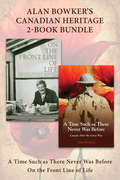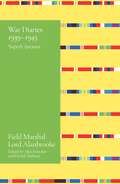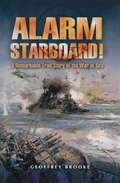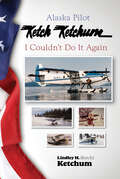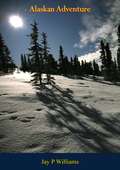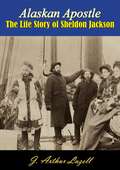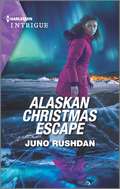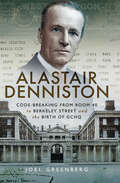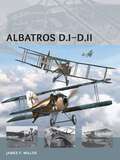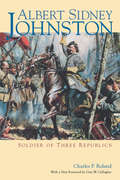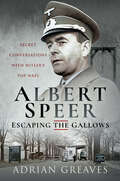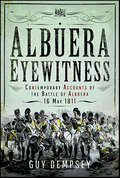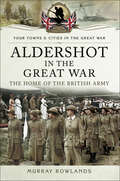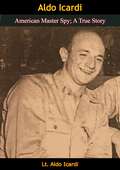- Table View
- List View
Alan Bowker's Canadian Heritage 2-Book Bundle: A Time Such as There Never Was Before / On the Front Line of Life
by Alan BowkerIn this two-book bundle, Alan Bowker sheds new light on two subjects with a surprising connection: the great Canadian writer Stephen Leacock and the rise of Canada on the world stage, which Leacock profiled with keen wit and observational skill. With Bowker as your guide, explore what it was really like to live through the great upheaval that pushed Canada to come into its own on the world stage. A Time Such as There Never Was Before Ottawa Book Award 2015 — Shortlisted The years after World War I were among the most tumultuous in Canadian history: a period of unremitting change, drama, and conflict. They were, in the words of Stephen Leacock, “a time such as there never was before.” The war had been a great crusade, and its end was supposed to bring a world made new. But the conflict had cost sixty thousand Canadian lives, with many more wounded, and had stirred up divisions in the young, diverse country. With Canada struggling to define itself, labour, farmers, business, the church, social reformers, and minorities all held extravagant hopes, irrational fears, and contradictory demands. Whose hopes would be realized, and whose dreams would end in disillusionment? Which changes would prove permanent and which would be transitory? A Time Such As There Never Was Before describes how this exciting period laid the foundation of the Canada we know today. On the Front Line of Life In the last decade of his life, Stephen Leacock turned to writing informal essays that blended humour with a conversational style and ripened wisdom to address issues he cared about most — education, literature, economics, Canada and its place in the world — and to confront the joys and sorrows of his own life. With an introduction that sets them in the context of his life, thoughts and times, these essays reveal a passionate, intelligent, personal Leacock, against a backdrop of Depression and war, finding hope and conveying the timeless message that only the human spirit can bring social justice, peace, and progress.
Alan Bristow, Helicopter Pioneer: The Autobiography
by Patrick Malone Alan Bristow&“You could be forgiven for taking Bristow&’s story as the invention of an action thriller writer . . . One of the best flying books you&’ll ever read.&” —Pilot Magazine Alan Bristow was a truly remarkable man. As a merchant navy officer cadet during the war, he survived two sinkings, played a part in the evacuation of Rangoon and was credited with shooting down two Stukas in North Africa. He joined the Fleet Air Arm and trained as one of the first British helicopter pilots, becoming the first man to land a helicopter on a battleship and Westland&’s first helicopter test pilot. He flew in France, Holland, Algeria, Senegal and elsewhere, narrowly escaping many helicopter crashes before winning the Croix de Guerre evacuating wounded French soldiers in Indochina. For four years he flew for Aristotle Onassis&’s pirate whaling fleet in Antarctica before joining Douglas Bader and providing support services to oil drillers in the Persian Gulf. Out of that grew Bristow Helicopters Ltd, the largest helicopter company in the world outside America. Bristow&’s circle included the great helicopter pioneers such as Igor Sikorsky and Stan Hiller, test pilots like Harold Penrose and Bill Waterton, Sheiks and Shahs and political leaders, business giants like Lord Cayzer and Freddie Laker, and the author James Clavell, a lifelong friend whose book Whirlwind was a fictionalized account of Bristow&’s overnight evacuation of his people and helicopters from revolutionary Iran. Bristow and precipitated the Westland Affair when he made a takeover bid which eventually led to the resignation of Michael Heseltine and Leon Brittain, and almost to the downfall of Margaret Thatcher.&“Has all the ingredients of a bestselling novel.&” —Firetrench
Alan Brooke—Churchill's Right-Hand Critic: A Reappraisal of Lord Alanbrooke
by Andrew SangsterThis new biography of Churchill&’s top WWII advisor is &“an excellent book for anyone interested in military leadership&” (The NYMAS Review). Voted the greatest Briton of the twentieth century, Winston Churchill has long been credited with almost single-handedly leading his country to victory in World War II. But without Alan Brooke, a skilled tactician, at his side the outcome might well have been disastrous. Brooke, Chief of the Imperial General Staff, more often than not served as a brake on some of Churchill&’s more impetuous ideas. However, while Brooke&’s diaries reveal his fury with some of Churchill&’s decisions, they also reveal his respect and admiration for the wartime prime minister. In return Churchill must surely have considered Brooke one of his most difficult subordinates—but later wrote that he was &“fearless, formidable, articulate, and in the end convincing.&” As CIGS, Brooke was integral to coordination between the Allied forces, and so had to wrestle with the cultural strategy clash between the British and Americans. Comments in his diaries offer up his opinions of both his British and American military colleagues—his negative assessments of Mountbatten&’s ability, and acerbic comments on the difficult character of de Gaulle and the weaknesses of Eisenhower. Conversely, he was clearly overindulgent in the face of Montgomery&’s foibles. Brooke was often seen as a stern and humorless figure, but a study of his private life reveals a little-seen lighter side, a lifelong passion for birdwatching, and abiding love for his family. The two tragedies that befell his immediate family were a critical influence on his life. Andrew Sangster completes this new biography with a survey of the way various historians have assessed Brooke, explaining how he has lapsed into seeming obscurity in the years since his crucial part in the Allied victory in World War II.
Alan Turing Decoded: The Man They Called Prof
by Dermot Turing‘A cracking read. ’Nick Smith, Engineering and TechnologyAlan Turing was an extraordinary man who crammed into his 42 years the careers of mathematician, codebreaker, computer scientist and biologist. He is widely regarded as a war hero grossly mistreated by his unappreciative country, and it has become hard to disentangle the real man from the story. It is easy to cast him as a misfit, the stereotypical professor. But actually Alan Turing was never a professor, and his nickname ‘Prof’ was given by his codebreaking friends at Bletchley Park. Now Dermot Turing has taken a fresh look at the influences on his uncle’s life and creativity, and the creation of a legend. He discloses the real character behind the cipher-text, answering questions that help the man emerge from his legacy: how did Alan’s childhood experiences influence him? How did his creative ideas evolve? Was he really a solitary genius? What was his wartime work after 1942, and what of the Enigma story? What is the truth about the conviction for gross indecency, and did he commit suicide? In Alan Turing Decoded, Dermot’s vibrant and entertaining approach to the life and work of a true genius makes this a fascinating and authoritative read.
Alanbrooke War Diaries 1939-1945: Field Marshal Lord Alanbrooke
by Lord AlanbrookeThe first complete and unexpurgated edition of the war diaries of Field Marshall Lord Alanbrooke - the most important and the most controversial military diaries of the modern era.Alanbrooke was CIGS - Chief of the Imperial General Staff - for the greater part of the Second World War. He acted as mentor to Montgomery and military adviser to Churchill, with whom he clashed. As chairman of the Chiefs of Staff committee he also led for the British side in the bargaining and the brokering of the Grand Alliance, notably during the great conferences with Roosevelt and Stalin and their retinue at Casablanca,Teheran, Malta and elsewhere. As CIGS Alanbrooke was indispensable to the British and the Allied war effort. The diaries were sanitised by Arthur Bryant for his two books he wrote with Alanbrooke. Unexpurgated, says Danchev, they are explosive. The American generals, in particular, come in for attack. Danchev proposes to centre his edition on the Second World War. Pre and post-war entries are to be reduced to a Prologue and Epilogue). John Keegan says they are the military equivalent of the Colville Diaries (Churchill's private secretary), THE FRINGES OF POWER. These sold 24,000 in hardback at Hodder in 1985.
Alanbrooke War Diaries 1939-1945: Field Marshall Lord Alanbrooke
by Lord AlanbrookeThe first complete and unexpurgated edition of the war diaries of Field Marshall Lord Alanbrooke - the most important and the most controversial military diaries of the modern era.Alanbrooke was CIGS - Chief of the Imperial General Staff - for the greater part of the Second World War. He acted as mentor to Montgomery and military adviser to Churchill, with whom he clashed. As chairman of the Chiefs of Staff committee he also led for the British side in the bargaining and the brokering of the Grand Alliance, notably during the great conferences with Roosevelt and Stalin and their retinue at Casablanca,Teheran, Malta and elsewhere. As CIGS Alanbrooke was indispensable to the British and the Allied war effort. The diaries were sanitised by Arthur Bryant for his two books he wrote with Alanbrooke. Unexpurgated, says Danchev, they are explosive. The American generals, in particular, come in for attack. Danchev proposes to centre his edition on the Second World War. Pre and post-war entries are to be reduced to a Prologue and Epilogue). John Keegan says they are the military equivalent of the Colville Diaries (Churchill's private secretary), THE FRINGES OF POWER. These sold 24,000 in hardback at Hodder in 1985.
Alarm Starboard!: A Remarkable True Story of the War at Sea
by Geoffrey Brooke&“Much more than a mere catalogue of a naval officer&’s experiences of war . . . All-in-all an excellent read and very highly recommended.&” —World Ship Society The author&’s naval war experiences make the most exciting reading. After being mined on the battleship Nelson in 1939, he served on the Prince of Wales, during the Bismarck action, witnessing the sinking of the Hood and Churchill and Roosevelt&’s historic meeting. He survived the disastrous sinking by Japanese dive-bombing in December 1941 but within two days of reaching Singapore, the Island fell. Evacuated in a coastal steamer, only to be sunk the next morning, he was stranded on a deserted island for a week before setting out for Ceylon in a native boat. His epic journey covered 1660 miles and took 37 days. Thereafter his adventures continued, with the North African landings, Russian convoys and, returning to the Far East. He was in the carrier Formidable when she was hit twice by Japanese Kamikazes before VJ Day August 1945.
Alaska Nellie
by Nellie Neal LawingNOT A GHOST WRITTEN ROMANCE…but the true story of an Alaskan pioneer who went North as a young girl during the exciting days of the development of the Alaskan Railroad. Offers of publishers to edit her copy and rewrite the book were repeatedly rejected in order that the story might be told accurately and the true sentiment of the writer in these later years be conveyed to the reader.Leaving gunfire and bloodshed in the rowdy mining camps of Cripple Creek, Colorado, Alaska Nellie—without friends or even acquaintances to turn to for advice or help—travelled along to the strange land that was then truly a frontier.The hardships she endured, the cold and hunger, miles of travel on foot, pulling a sled without the aid of dogs, the dangers she encountered and kind assistance she gave to those in need have made her name one that is known and loved throughout the entire territory.Everyone will enjoy this thrilling story of one of the few woman pioneers who lived to “carry on.”
Alaska Pilot Ketch Ketchum: I Couldn't Do It Again
by Ketch KetchumKetch Ketchum's story is like many other people who grew up in America's Great Depression. He was raised on his parents' homestead in Readyville, Idaho. Ketch and his brothers milked cows, dug postholes, collected firewood, and marched to the tune of a strict father. He joined the Army Air Corp in 1942, married his high school sweetheart, Marguerite, and traveled the world with the new United States Air Force. Ketch retired as a Major Command pilot in 1964 and this is when his Alaska adventure begins. Traveling north on the Alaska Canada Highway in a trailer with three kids, the family's road ended in Anchorage, Alaska. Ketch, building on his Air Force flying career, mastered the single engine planes of the Alaska bush pilots. Eventually he and Marguerite established Ketchum Air Service on Lake Hood and never looked back. The next 35years was devoted to flying the Alaska wilderness. He transported hunters and fishermen, flew ski-planes for winter seismic exploration on the North Slope, supplied aircraft support during the Exxon Valdez oil spill cleanup, and grew the air service business from one to twelve airplanes.
Alaskan Adventure
by Jay P WilliamsThis is a book by a man at home in Alaska, giving incidents of his life there and of the country itself. Jay Williams tells about Alaska as he knew it. He describes with affection both the country and the men who surrounded him, giving many accounts of encounters with the wildlife of the area—predominantly those ending in rifle shots, but in later years, those ending with camera shots instead.Williams devotes a good deal of space to the animals themselves and also gives information about the various areas of Alaska most familiar to him. Most of all, he gives sound advice on the experience, alertness and provisions needed by a man who copes with the wilderness and its animal inhabitants. In the appendices there is advice on equipment and technique for camp and trail and, written by Townsend Whelen, directions for making the Alaskan packboard and hunters’ lean to tent.
Alaskan Apostle: The Life Story of Sheldon Jackson
by J. Arthur LazellHow the extraordinary career of one man--missionary, educator, explorer, statesman--changed the course of history on the untamed Arctic frontier...Originally published in 1960, Alaskan Apostle is a fascinating biography about Sheldon Jackson, a Presbyterian minister who founded schools in Alaska.He was regarded as "one of the most exciting and courageous men of all those who worked on the American frontier. The roles he played in Alaska and in the American West form an incredible chapter in the effort of the Church to keep pace with the developing nation.Jackson was man and missionary, government official and spiritual empire builder. He was responsible for saving the Alaskan Eskimos from extinction and for the founding of Alaska's school system. He did more than any other person in the nineteenth century to inform the American nation about Alaska's needs and people. His failure to accomplish all he hoped to do is, in large part, due to the disgraceful inaction of successive Congresses.Jackson was prepared to lay down his life as an apostle to Alaska, convinced that 'if God be for us, who can be against us?' His spiritual life and moral and physical courage are what churchmen need today if they hope to discharge their responsibilities to the total life of the nation."
Alaskan Christmas Escape (Fugitive Heroes: Topaz Unit #2)
by Juno RushdanWith a death squad in pursuit…A fugitive needs the help of a wounded warrior. An elite CIA kill squad has located hacker Zenobia Hanley&’s Alaska wilderness hideout. With commandos hot on Zee&’s heels, she&’s saved from capture by her neighbor John Lowry. Zee has kept her yearning for the SEAL, who has a disability, in check to shield him. But, despite her secrets, John&’s determined to protect Zee regardless of the risks. Because there&’s more at stake this Christmas than just their lives.From Harlequin Intrigue: Seek thrills. Solve crimes. Justice served.Discover more action-packed stories in the Fugitive Heroes: Topaz Unit series. All books are stand-alone with uplifting endings but were published in the following order: Book 1: Rogue Christmas OperationBook 2: Alaskan Christmas EscapeBook 3: Disavowed in WyomingBook 4: An Operative's Last Stand
Alastair Denniston: Code-Breaking from Room 40 to Berkeley Street and the Birth of GCHQ
by Joel Greenberg“The expertly researched biography of the man who created and led the British intelligence organization best known for cracking the Nazi’s codes.” —Midwest Book Review Some of the individuals who played key roles in the success of Bletchley Park in reading the secret communications of Britain’s enemies during the Second World War have become well-known figures. However, the man who created and led the organization based there, from its inception in 1919 until 1942, has, surprisingly, been overlooked—until now. In 1914 Alastair Denniston, who had been teaching French and German at Osborne Royal Navy College, was one of the first recruits into the Admiralty’s fledgling codebreaking section that became known as Room 40. There, a team drawn from a wide range of professions successfully decrypted intercepted German communications throughout the First World War. After the Armistice, Room 40 was merged with the British Army’s equivalent section—MI1—to form the Government Code and Cypher School (GC&CS). Initially based in London, from August 1939, GC&CS was largely located at Bletchley Park, with Alastair Denniston as its Operational Director. With the support and assistance of both the Denniston family and GCHQ, Joel Greenberg, author of Gordon Welchman: Bletchley Park’s Architect of Ultra Intelligence, has produced this absorbing story of Commander Alexander “Alastair” Guthrie Denniston OBE, CBE, CMG, RNVR, a man whose death in 1961 was ignored by major newspapers and the very British intelligence organization that was his legacy. “An enthralling account of Alastair Denniston and his contribution to modern electronic intelligence. This book follows from his excellent biography of another great of signals intelligence, Gordon Welshman.” —Fire Reviews
Albatros D.I-D.II
by James MillerIn 1916 German aerial domination had been lost to the French and British fighters. German fighter pilots requested an aircraft that was more powerful and more heavily armed, and the Albatros design bureau set to work on what was to become an iconic aircraft design. By April 1916, they had developed the Albatros D.I, that featured the usual Albatros semi-monocoque wooden construction with a 160hp Mercedes engine and two forward-firing machine guns. Alongside the development of the D.I, Albatros had also designed and built a second machine that was similar to the D.I - the Albatros D.II. Although there were several external differences between the two aircraft, it is important to note that these machines evolved simultaneously and that the D.II was not the result of post-combat feedback from D.I pilots. With the inclusion of these aircraft into their reorganized air force, Germany was able to regain control of the skies by autumn 1916. Along with the later designs they inspired, the Albatros D.I and D.II were instrumental in allowing the Germans to prosecute their domination through 'Bloody April' and well into the summer months that followed.
Albatros D.III
by James MillerIn 1916, Imperial German aerial domination, once held by rotary-engined Fokker and Pfalz E-type wing-warping monoplanes, had been lost to the more nimble French Nieuport and British DH 2s which not only out-flew the German fighters but were present in greater numbers. Born-from-experience calls from German fighter pilots requested that, rather than compete with the maneuverability of these adversaries, new single-engine machines should be equipped with higher horsepower engines and armed with two, rather than the then-standard single machine guns. The Robert Thelen-led Albatros design bureau set to work on what became the Albatros D.I and D.II and by April 1916 they had developed a sleek yet rugged machine that featured the usual Albatros semi-monocoque wooden construction and employed a 160hp Mercedes D.III engine with power enough to equip the aeroplane with two forward-firing machine guns. Visual hallmarks of the D.I and early production D.II include fuselage mounted Windhoff radiators and matching chords for the upper and lower wings. Meanwhile, Albatros had already produced the prototype of the D.II's successor, the D.III. Influenced by the French Nieuport sesquiplane design, the D.III featured lower wings of reduced chord and single-spar construction, with the interplane struts now meeting the lower wings in a 'V'. After arriving at the Front en masse in early 1917, the Royal Flying Corps did not possess a fighter that could arrest the Albatros' onslaught against the RFC reconnaissance machines and thus they suffered appalling casualties in a desperate period known as 'Bloody April'. However, despite the D.III's success, the sesquiplane design led to structural flaws that resulted in the deaths of several pilots, which caused the type to be grounded until the lower wings could be strengthened or replaced. Still, even after their return to service, German pilots knew not to prosecute a dive too aggressively lest they invite structural catastrophe.Always chasing performance enhancements, by the time of 'Bloody April' Albatros had already designed and received a production order for the D.V.D.IIIs were manufactured concurrently but production was shifted to the Ostdeutsche Albatros Werke (OAW) in Schneidmuhl, where they received more robust construction. They differed little from their Johannisthal D.III brethren externally, save for a slightly different skin application on the nose and a D.V-type rudder, which had a curved rather than straight trailing edge. They also had Mercedes engines of 175 hp, versus the 160 hp engines of the Johannisthal D.III. Overall they benefitted from the teething experience of the earlier D.IIIs and avoided the structural problems that resurfaced with the Johannisthal-built D.Vs. In all, 500 D.IIIs and 840 D.III(OAW)s were produced and saw heavy service throughout 1917. They extracted a serious toll on the enemy but as the year progressed faced an increasing number of new enemy fighter types, including the Sopwith Pup, Sopwith Triplane, SPAD VII, and SE5a, but remained at the Front in high numbers (446 of both types were recorded on 31 October) until dwindling in spring 1918 (from 357 in February to 82 in June) with the arrival of the Fokker Dr.I and D.VII.
Albert Ball VC: The Fighter Pilot Hero of World War I
by Colin PengellyAn action-packed military biography of a British fighter pilot and his rise through ranks during World War I. World War I pilot Albert Ball&’s invincible courage and determination made him a legend not only in Britain but also amongst his enemies, to whom the sight of his lone Nieuport Scout brought fear. Ball enlisted in the British army in 1914 with the 2/7th Battalion (Robin Hoods) of the Sherwood Foresters, Notts, and Derby Regiment. By October, 1914, he had reached the rank of Sergeant and then became Second-Lieutenant to his own battalion in the same month. In June, 1915, he trained as a pilot in Hendon. Then in October, he obtained Royal Aero Club Certificate and was transferred to the Royal Flying Corps. He further trained at Norwich and Upavon, being awarded the pilot&’s brevet in January, 1916. In May, he opened his score, shooting down an Albatros C-type over Beaumont. Days later he shot down two LVG C-types, while flying his Nieuport 5173. Captain Albert Ball made his final flight on May 7, 1917, when he flew as part of an eleven-strong hunting patrol into action against Jagdstaffel 11, led by Lothar Von Richthofen. Albert was pursuing the Albatros Scout of Lothar, who crash-landed, wounded. Then many witnessed Albert dive out of a cloud and crash. He died minutes later in the arms of a French girl, Madame Cecille Deloffre. Ball rose from obscurity to the top rank of contemporary fighter pilots in only 15 months. In that period, he had been awarded the MC, DSO, and two Bars, and was credited with at least 44 victories.
Albert Kesselring
by Adam Hook Pier BattistelliAlthough he is mostly remembered for his part in the campaign in Italy from 1943 to 1945, Generalfeldmarschall Albert Kesselring was also chief of staff of the Luftwaffe in 1936-37, playing a crucial role in the shaping of the service for the coming war. As commander of Luftflotte 1 in Poland and Luftflotte 2 in France and the Low Countries, he was responsible for supporting the armoured spearheads of the German Army as they undertook their Blitzkrieg campaigns. With the Fall of France, the Battle of Britain began and Luftlotte 2 was the main force in the air attack against the British air defences, with Kesselring planning many raids. Following the war Kesselring was tried and convicted of war crimes following a number of massacres of civilians in Italy. He was sentenced to death, later commuted to life imprisonment before being released on the grounds of ill health in October 1952. Here Pier Paolo Battistelli provides a detailed study of one of the most famous German commanders of World War II.
Albert Schwenn's Memories of the Waffen-SS: An SS Cavalry Division Veteran Remembers
by Rolf Michaelis Albert SchwennA firsthand account from a member of the SS Cavalry Division, and SS Cavalry Training and Replacement Battalion
Albert Sidney Johnston: Soldier of Three Republics
by Charles P. RolandA biography of the man whom Jefferson Davis could have considered one of his greatest generals during the American Civil War. A revised edition of the only full-scale biography of the Confederacy&’s top-ranking field general during the opening campaigns of the Civil War. Albert Sidney Johnston was selected as one of the best one hundred books ever written on the Civil War by Civil War Times Illustrated in 1981 and by Civil War: The Magazine of the Civil War Society in 1995.Featuring a new forward by Gary W. Gallagher and a new preface by the author Praise for Albert Sidney Johnston &“A biography of the Kentucky native who might have been mentioned in the same breath as Robert E. Lee had Johnston not died while commanding Confederate troops at the battle of Shiloh in 1862, only a year after the war started.&”—Lexington Herald-Leader &“Johnston&’s early years, military career, and encounters with Indians, Mormons, and Union soldiers are the focus of this &“masterly&” study.&”—Civil War Book Review &“The view of army life and the terrible decisions that many southern officers had to make at the beginning will provide an excellent background for further understanding the Civil War.&”—Paper Wars
Albert Speer—Escaping the Gallows: Secret Conversations with Hitler's Top Nazi
by Adrian GreavesAt the Nuremberg War Crimes Tribunal, Albert Speer, Hitler’s one-time number two, persuaded the judges that he ‘knew nothing’ of the Holocaust and related atrocities. Narrowly escaping execution, he was sentenced to twenty years in Spandau Prison, Berlin. In 1961, the newly commissioned author, as the British Army Spandau Guard Commander, was befriended by Speer, who taught him German. Adrian Greaves’ record of his conversations with Speer over a three year period make for fascinating reading. While the top Nazi admitted to Greaves his secret part in war crimes, after his 1966 release he determinedly denied any wrongdoing and became an intriguing and popular figure at home and abroad. Following Speer’s death in 1981 evidence emerged of his complicity in Hitler’s and the Nazi’s atrocities. In this uniquely revealing book the author skilfully blends his own personal experiences and relationship with Speer with a succinct history of the Nazi movement and the horrors of the 1930s and 1940s. In so doing new light is thrown on the character of one of the 20th century’s most notorious characters.
Albuera Eyewitness: Contemporary Accounts of the Battle of Albuera, 16 May 1811
by Guy DempseyOn 16 May 1811, the small town of Albuera was the setting for one of the Peninsular War’s most bloody and desperate battles. A combined Spanish, British and Portuguese force of more than 30,000 men, under the command of Lord Beresford, stubbornly blocked the march of the French field marshal Soult, who was trying to reach the fortress of Badajoz, twelve miles to the north. However, after suffering losses of up to 7,000 men during the fighting, Wellington declared that, ‘Another such battle will ruin us’. One British regiment, the 57th Foot, suffered casualties of more than 50 per cent. Similarly, the French fought with enormous tenacity, and sustained almost equally heavy losses. The stories from those who fought in the battle on both sides make for both chilling and inspiring reading. These contemporaneous accounts include letters, diaries, official correspondence, army records, maps, newspaper reports and memoirs totaling over 100 contemporary accounts of the battle. They range from the comprehensive after-action reports of the British, Portuguese, Spanish and French commanders to casualty and prisoner lists and to recollections of individual soldiers from all the combatant armies. The purpose of this book is to tell the story of the battle exclusively by way of these primary sources, with English translations for foreign language sources, along with, in each case, a commentary identifying the source and its context. The heart of the work will be a vast number of first-hand accounts providing astonishing details of the intense fighting including the heroism of the Spanish troops, the massacre of Colborne’s brigade by Polish lancers, Beresford’s near-fatal indecisiveness, and the heroic charge of the Fusilier brigade. This presentation allows readers avid for detailed historical information to draw their own conclusions about how the events of the battle unfolded.
Alchemy of a Blackbird: A Novel
by Claire McMillanFor fans of The Age of Light and Z comes a &“beguiling novel of artistic ambition, perseverance, and friendship&” (Katy Hays, New York Times bestselling author) based on the true story of the 20th-century painters and tarot devotees Remedios Varo and Leonora Carrington.In this &“unforgettable adventure, and one you don&’t want to miss&” (Patti Callahan Henry, New York Times bestselling author), painter Remedios Varo and her lover, poet Benjamin Peret escape the Nazis by fleeing Paris and arriving at a safe house for artists on the Rivieria. Along with Max Ernst, Peggy Guggenheim, and others, the two anxiously wait for exit papers. As the months pass, Remedios begins to sense that the others don&’t see her as a fellow artist; they have cast her in the stifling role of a surrealist ideal: the beautiful innocent. She finds refuge in a mysterious bookshop, where she stumbles into a world of occult learning and intensifies an esoteric practice in the tarot that helps her light the bright fire of her creative genius. When travel documents come through, Remedios and Benjamin flee to Mexico where she is reunited with friend and fellow painter Leonora Carrington. Together, the women tap into their creativity, stake their independence, and each find their true loves. But it is the tarot that enables them to access the transcendent that lies on the other side of consciousness and to become the truest Surrealists of all.
Alcibiades
by P. J. RhodesWhile the Americans were fighting in Vietnam, a struggle of even greater strategic significance was taking place in the Middle East: the Sultanate of Oman guards the entrance to the Arabian Gulf, and thus controls the movement of oil from that region. In the 1960s and 70s, the Communists tried to seize this artery and, had they succeeded, the consequences for the West and for the Middle East would have been disastrous — and yet, few people have ever heard of this geo-political drama at the height of the Cold War.In the Service of the Sultan tells, first-hand, the largely unknown story of a small number of British officers who led Muslim soldiers in this hard-fought anti-insurgency war which has shaped todays Gulf. After outlining the historical, geographical and political background, the book describes military action in a stark and mountainous environment, including operations with irregular forces and the SAS as well as action in the air and at sea. The book gives a gripping, moving, funny account of all these and paints a powerful and illuminating picture of the realities of war.It will appeal to all who are interested in the Cold War and relationships between the Western and the Arab worlds. Politics, history, irregular warfare, religion, international affairs: all are ingredients in this absorbing, informative read. In the light of the current insurgencies in Iraq and Afghanistan, it is also timely to be reminded how a rare victory was won over Communist guerrillas.
Aldershot in the Great War: The Home of the British Army
by Murray RowlandsThe first book written about Britain's premier army base in the First World War.The book contains and explores the following: The first published record of the troops in Aldershot on 4 August 1914. The first published list of officers and men from Aldershot killed in the war. Lists the dead from WWI in Aldershot Cemetery. Outlines the activities of crucial figures in the War such as Smith-Dorrien, Haig and French in Aldershot in the period before the War. Traces the growth development of aircraft manufacture at Farnborough under the guidance of Mervyn O'Gorman from a balloon factory to major aircraft manufacture. Highlights the changes in the social fabric of Aldershot during the war. Records the experience of Aldershot as a premier training base through the eyes of Anthony Eden, Wilfred Owen and men of all ranks.
Aldo Icardi: American Master Spy; A True Story
by Lt. Aldo IcardiAldo Icardi (1921-2011) was a U.S. Army second lieutenant during World War II who was sent as a specially-trained soldier by the U.S. Army’s Office of Strategic Services (OSS) on a special mission into enemy-occupied territory in Italy to organize resistance movements. During this mission, which was code-named “Chrysler,” its commander Major John William V. Holohan disappeared, and Lt. Icardi, along with radio operator Carl G. LoDolce and three Italians, was charged with his murder. The Italians, who spent three years in jail, were later acquitted, and Icardi and LoDolce were convicted in absentia of murder and sentenced to life and 17 years respectively, but neither man could be extradited back to Italy, so did not serve time. In 1955, Icardi was indicted by a federal grand jury for perjury, but was acquitted in 1956. The Italian Communist commander Vincenzo Moscatelli later admitted that he was responsible for Major Holohan’s death and that Icardi had nothing to do with it.With this book, which was first published in 1954, Aldo Icardi seeks to set the record straight on all the newspaper stories that circulated in the wake of the killing, and ever since.A gripping true-life story.“This book is the true story, as well as I know it, of what actually happened to Major Holohan. It is my defense against the charges of murder. And it is the story of the most dangerous and exciting eight months I have ever lived.”—Aldo Icardi
